![]()
![]()
![]()
Use LEFT and RIGHT arrow keys to navigate between flashcards;
Use UP and DOWN arrow keys to flip the card;
H to show hint;
A reads text to speech;
43 Cards in this Set
- Front
- Back
|
What vessels branch off of the ascending aorta? |
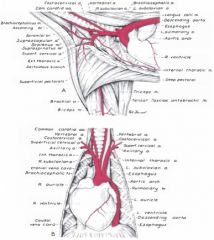
Coronary aa.
|
|
|
What vessels branch off of the aortic arch?
|
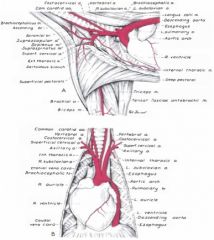
L. subclavian, brachiocephalic trunk
|
|
|
What vessels branch off of the Brachiocephalic trunk? |
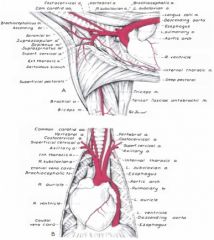
R and L common carotid, R subclavian a.
|
|
|
What vessels branch off of the descending aorta? |
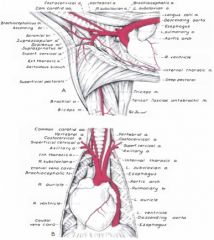
Dorsal intercostal aa., bronchoesophageal a.
|
|
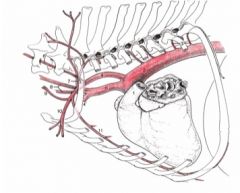
What are 4, 4', 5, 6, 7, 8, 9, 10 and 11 in this picture?
|

4. Left subclavian a.
4'. Right subclavian a. 5. Brachiocephalic trunk 6. Vertebral a. 7. Costocervical trunk 8. Left and right common carotid aa. 9. Superficial cervical a. 10. Axillary a. 11. Internal thoracic a. |
|
|
Where does the vertebral artery course?
|

Through the transverse foramina of C6-C1 vertebrae
|
|
|
What does the vertebral a. supply with blood?
|

The cervical muscles
|
|
|
Does the vertebral a. course through the transverse foramen or the lateral vertebral foramen?
|
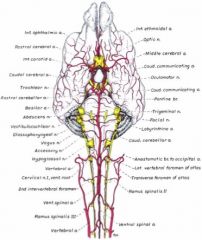
Both you silly peanut! It courses through the transverse foramen until the atlas, when it veers dorsally and goes through the lateral vertebral foramen to become the basilar a.
|
|
|
The vertebral a. branches to form what two vessels?
|
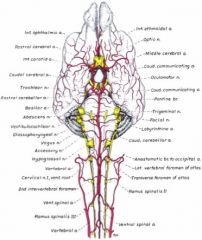
Ventral spinal a. and basilar a.
|
|
|
Which vessel is the largest source of blood to the brain?
|
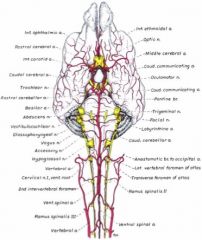
The basilar a. It is a branch of the vertebral a. The ventral spinal a. (also from branches of the verberal a.) fuses with it to supply the brain with blood.
|
|
|
What branches from the costocervical trunk?
|
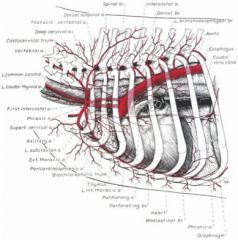
Dorsal scapular a.
Deep cervical a. Thoracic vertebral a. |
|
|
What does the thoracic vertebral a. gives rise to what?
|
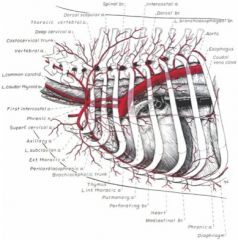
The first three dorsal intercostal aa.
|
|
|
What artery courses deep to transversus thoracis m.?
|
Internal thoacic a.
|
|
|
What branches off of the internal thoracic a.?
|
Ventral intercostal aa.
|
|
|
What is the terminal branch of the internal thoracic artery? |
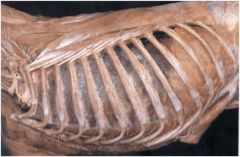
Cranial deep epigastric a.
|
|
|
Where does the cranial epigastric a. emerge from the thorax?
|
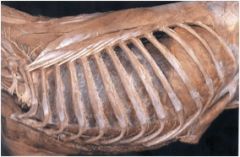
Caudal to the costal arch.
|
|
|
What artery perforates rectus abdominis m. and runs caudally on the superficial surface of rectus abdominis m.?
|
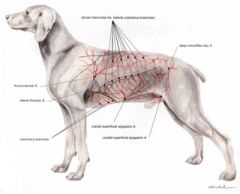
Cranial superficial epigastric a.
|
|
|
What name does the descending aorta go by in the thoracic portion and abdominal portion?
|
Thoracic aorta and abdominal aorta. The aorta is not a very clever or creative vessel.
|
|
|
Are the lungs and esophagus fed by the same aa.?
|

Yes - both the bronchial and esophageal brs. derive from the bronchoesophageal aa.
|
|
|
Where do the intercostal aa. arise from?
|
1-3 arise from costocervical trunk
4-12 arise directly from aorta |
|
|
Are the dorsal or ventral intercostal aa. thicker?
|
The dorsal, because they are coming from the high pressure lifestyle of the aorta.
|
|
|
Where do the intercostal vessels and nerves course?
|
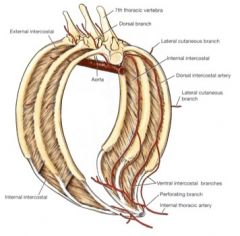
Along the caudal border of each rib.
Additional branches from the internal thoracic vessels course cranial to the ribs more ventrally. |
|
|
Why are we likely to be asked about the path that the intercostal vessels and nerves take?
|
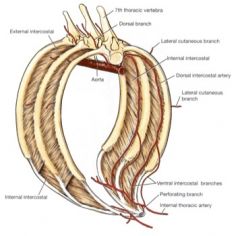
She’s likely to ask us where these vessels and nerves course (along caudal border of each rib), because clinically, we’ll need to know to not incise there. Ventrally, it gets trickier, as branches cross to the cranial border, and great care should be taken.
|
|
|
Describe how the cranial vena cava branches to the subclavian level.
|
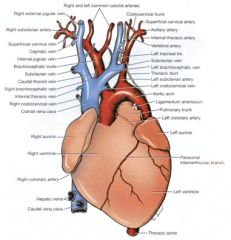
The cranial vena cava branches to form the right and left brachiocephalic vv. These branch to form the R and L subclavian and external jugular vv.
|
|
|
T/F
Only the left azygous develops? |

False. Only the right azygous develops.
|
|
|
T/F
The azygous drains blood from both R and L body walls? |
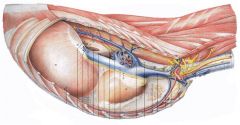
True. The azygous collects blood from the dorsal intercostal veins which drain blood from the dorsal third of the thoracic wall.
|
|
|
Where do the dorsal intercostal vv. drain into?
|
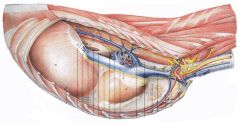
The azygous vein.
|
|
|
What do the R and L internal thoracic veins usually drain into?
|
A common trunk, which drains into the cranial vena cava.
|
|
|
In the dog, what might the left internal thoracic vein independently drain into? And independent of what?
|
It might drain independtly into the left brachiocephalic vein. "Normally" both R and L internal thoracic veins would drain into a common trunk and then into the cranial vena cava.
|
|
|
Where do the dorsal and ventral intercostal veins drain into? |
Dorsal - into the azygous v.
Ventral - into the internal thoracic v. |
|
|
Which will be larger, dorsal or ventral intercostal veins and why?
|
Ventral intercostal veins will be larger because 2/3 of the blood will drain into them.
|
|
|
Where would you be able to locate the thoracic duct?
|
The left side.
|
|
|
Where does the thoracic duct carry lymph from?
|
The cisterna chyli at the level of the diaphragm to the venous system cranial to the heart
|
|
|
Where does the thoracic duct drain its lymph into?
|
usually drains into the external jugular vein, cranial vena cava or left brachiocephalic vein
|
|
|
What does the thoracic duct course with?
|
The aorta and azygous v.
|
|
|
How does the placement of the aorta differ in dogs and cats?
|
In the dog, at the level of heart, the thoracic duct passes obliquely from the right to the left, crossing the esophagus
In the cat, the thoracic duct is located to the left of the aorta in the caudal part of the mediastinum |
|
|
Where does the thoracic duct course to?
|
It follows the esophagus to the thoracic inlet.
|
|
|
What is the goal of the lymphatic system?
|
To get the lymph back into the veinous system.
|
|
|
Where do the lymphatics usually dump the lymph into the veinous system?
|
Usually cranial to the heart.
|
|
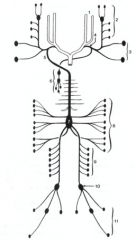
What is #7?
|

Cisterna chyli
|
|

What is #5?
|
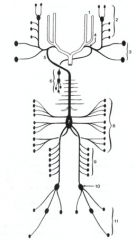
Thoracic duct
|
|
|
Where does abdominal lymph drain?
|
Drains into the cisterna chyli.
|
|
|
Where does lymph from the cisterna chyli go?
|
Up the thoracic duct to drain into the external jugular (usually). Or drain into the cranial vena cava. Or into the left brachiocephalic v. That's it.
|

